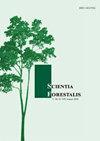Índices de vegetação para análise nutricional de Eucalyptus saligna Smith usando espectrorradiometria
IF 0.4
4区 农林科学
Q4 FORESTRY
引用次数: 0
Abstract
This study aimed to explain the association between macroand micro-nutrients with vegetation indices and to determine the most important wavelengths for each nutrient. In addition, equations capable of describing the nutritional status of Eucalyptus saligna Smith stands based on spectral radiometric data were suggested. The research was carried out in an 18-month-old plantation located in Barra do Ribeiro, Rio Grande do Sul State, Brazil. For the reflectance measurement 12 samples were used, which also served for the chemical quantification of macro and micronutrients. Nutrients were estimated by using multiple linear regression. The results showed that the visible and red-edge regions are more sensitive for discriminating nutrients in plants, mainly Mn, P, Ca, and S. In the macronutrient modeling, the estimation of N, Ca, and S, yielded the best adjustments, while in the micronutrient group the best adjustments were yielded by Zn, Cu, and Mn. Thus, the present study demonstrated the effectiveness of spectral radiometry to analyze nutrients in vegetation, which can be used in a fast and practical way to diagnose the nutritional status of eucalyptus.利用光谱辐射法对桉树营养分析的植被指数进行分析
本研究旨在解释大、微量营养素与植被指数之间的关系,并确定每种营养素的最重要波长。此外,还提出了基于光谱辐射数据的描述盐叶桉林分营养状况的方程。该研究是在巴西南里奥格兰德州Barra do Ribeiro的一个18个月大的种植园进行的。反射率测量用了12个样品,同时也用于常量和微量元素的化学定量。利用多元线性回归估计营养成分。结果表明,可见区和红边区对植物中主要以Mn、P、Ca和S为主的营养元素判别更为敏感。在宏量元素模型中,N、Ca和S的估算调节效果最好,而在微量元素组中,Zn、Cu和Mn的估算调节效果最好。因此,本研究证明了光谱辐射法分析植被营养成分的有效性,可以快速实用地诊断桉树的营养状况。
本文章由计算机程序翻译,如有差异,请以英文原文为准。
求助全文
约1分钟内获得全文
求助全文
来源期刊

Scientia Forestalis
Agricultural and Biological Sciences-Forestry
CiteScore
1.00
自引率
0.00%
发文量
39
期刊介绍:
Scientia Forestalis is a scientific publication of the IPEF – Institute of Forest Research and Studies, founded in 1968, as a nonprofit institution, in agreement with the LCF – Department of Forest Sciences of the ESALQ – Luiz de Queiroz College of Agriculture of the USP – São Paulo University. Scientia Forestalis, affiliated to the ABEC – Brazilian Association of Scientific Publishers, publishes four issues per year of original papers related to the several fields of the Forest Sciences.
The Editorial Board is composed by the Editor, the Scientific Editors (evaluating the manuscript), and the Associated Editors (helping on the decision of acceptation or not of the manuscript, analyzed by the Peer-Reviewers.
 求助内容:
求助内容: 应助结果提醒方式:
应助结果提醒方式:


